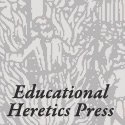On reading this article I was immediately transported to the visions, writing and practice of our own Philip Toogood. He championed the idea of mini-schooling and wrote a manual for Education Now Press. Virtually everything here is something that Philip practised both in mainstream comprehensive schools and the alternative settings he developed over his career. The point is many of these ideas are well known to radical and alternative educators. They have been practised for decades yet mainstream is so reluctant to learn from them. If High Tech High wants to take things another step I’d recommend they took on board ideas like ‘invitation, choice – alternatives for everybody all of the time’ – all principles at the heart of CPE-PEN values.
Is High Tech High the most innovative school in the US? November 13, 2009. By David Jackson
When Larry Rosenstock and Ted Sizer were contemplating the blueprint for the first High Tech High school ten years ago, they debated the measure by which they would want to be judged.
They asked themselves: why does it seem impossible for all children in a mixed community to go to University? They decided University admission would be the test by which they would judge their new school.
High Tech High went on to pass with flying colours: since the first school opened, 99.5% of students have gone to University. Examined in detail, the figures are even more remarkable: 55% of students are the first generation in their family to attend University. 88% of their poorer students on free or reduced school dinners complete a University degree. These numbers are hard to ignore.Larry Rosenstock is now Chief Executive of High Tech High, a group of nine Charter schools in San Diego (one elementary, three middle and five high schools), each containing no more than 400 students. Rosenstock spoke at the Guardian/Innovation Unit ‘Innovation in Education’ conference on 9 November, and the Learning Futures national event the following day. I saw him both times – I’ve also been to San Diego to see High Tech High in action, and it is quite possibly the most impressive and the most innovative school I have ever seen. So what makes it so different?
An innovative curriculum
The High Tech High curriculum supports personalised, project-based learning with pervasive connections to the community. Visit the schools, and you see every available surface covered with the students’ projects – which are regularly showcased to the wider community in popular open-house events, as well as other public spaces.
Everything starts with student engagement. Students are given the satisfaction of thinking, making and doing. The learning is personalised and integrates the rigour of academic content with the application of vocational pedagogy – hence their name High Tech High.
Learners as producers
“Kids do production not consumption” at High Tech High. As Rosenstock says, “High quality work means high quality teaching – we let practice speak through demonstrations of student work.” Several student projects have been published, and are available in bookshops (and on Amazon) – for example, Perspectives of San Diego Bay (a biology field guide to the bay) and Calculicious (a collection of artwork by students that explores calculus).
Learning disciplines
They do not focus on standardized tests, which “suck oxygen out of the system”. Learning is about enquiry, collaboration, kids doing and making and shaping things. “Memorising 500 biology words makes people think that they don’t want to be biologists. Behaving like a biologist does. Our students behave like mathematicians or historians or photographers or writers. They are encouraged to think like someone who learns for a living.”
Small Schools
They are small schools so that students are known – and Bill Gates, whose Foundation has supported the Small Schools movement across America, is a huge supporter of High Tech High, which he says shows that “You can work hard and have fun”.
So, how do they make it work?
Rich descriptions of innovative practice sometimes fail to identify the critical building blocks – the way something is organised, the systems, and management practices that enables astonishing educational achievement to happen. Some of these building blocks at High Tech High, in addition to their own outstanding leadership, include the following:
•All lessons are collaboratively planned and they build from teacher and student passions (see ‘Where Do Projects Come From?’ or ‘Into the World of Projects’ ).
•Nothing changes for student learners unless staff are also learning together, so “Students learn in teams and teachers learn in teams”. The school year begins with a two or three week ‘Odyssey’ during which staff work and learn together in collaborative teams to undertake a curriculum project that students will do later that year. At the end they present their work. Together, they learn the pedagogical models that they will use with their students.
•More unusually, staff engage in one hour’s professional development before school every day. During this time they plan together, they study student work and they observe themselves teaching. They have examined staff learning time, and it discovered that it works best at the start of the day, not the end (for obvious reasons). Larry Rosenstock believes that the cumulative effect of this learning time is much more important than any set of formal qualifications the teachers might have.
•There are also two full-time videographers, so they are able constantly to study teachers teaching and students learning, and to refine and problem-solve their practices.
•Assessment is ‘authentic’ – including presentation, exhibition, performance in front of peers, family and the community.
•Staff design the adult learning materials for their credentialing programmes and their Masters programmes. They produce their own in-house education journal called ‘Unboxed’ and all work – teacher and student work – is public and available for others to learn from. Anyone visiting the High Tech High site can access this rich resource (and you can watch a series of videos, too)
•In addition, staff (like students) are recognized both as producers – all syllabi and portfolios of work are online and publicly available from the school’s digital commons , and as learners – High Tech High school certifies its own teachers, and provides Masters-level programmes both for its own teachers and for others.
Teachers routinely craft lessons that blend subjects. Teacher loyalty is not to other teachers who teach the same subject as them, but to other teachers who teach the same students at the same time. That way the gates are open for the planning of integrated work programmes. It is customary, therefore, to timetable together groups of students with small teams of teachers who plan together and make public their work plans. The quality of these curricular and pedagogic designs are subsequently judged by the outcomes of student work. Some work better than others, but that is how they learn.
As a result, teachers want to work at High Tech High. They receive hundreds of applications for every vacancy, yet no-one has tenure – not Larry Rosenstock nor any other teacher (“Why would you want to retain a teacher who can’t produce outstanding student work?”).
So what is the big idea?
At the core of High Tech High is a philosophy of integration. “At High Tech High we are committed to desegregating kids. We are committed to both a diverse and an integrated community in which all students follow College graduation programmes.” Integration begins with the community, but it goes much further. They integrate:
•across social class (following Thomas Jefferson’s belief that the purpose of public education is both to serve the public and to create a public)
•school and community – in Rosenstock’s words, “You don’t want to isolate school from the community kids are going out into. You want the walls to be as permeable as possible, with adults coming in and learning going out.”
•public and private – because San Diego business leaders are stakeholders in the schools’ success.
•secondary and post-secondary education, assuming that all students have the potential to progress to College if they choose. (Rosenstock cites his grandmother: “There are two kinds of people, those who think that there are two kinds of people and those who don’t.”)
•head and hand (following John Dewey’s belief that understanding derives from activity; from making and doing)
•learning with assessment.
This set out to be a provocation piece, but the provocation lies not so much in the argument as in the evidence of an alternative approach to secondary schooling that produces extraordinary results.
High Tech High has turned away from much of what is outdated and self-defeating about traditional schooling – classroom design, divisions between subjects, isolation from the community, limiting belief systems about student potential, assessments that only one teacher ever sees, a model of school that fails to inspire and develop staff.
Having found such a model, are we in the UK able to learn from and seek to emulate the ambition and the passion and the practices of High Tech High? It is not the only successful alternative model for secondary schools, but it is one that is within our grasp.
If you are a school leader in the UK, and you want to apply this learning, where would you start?
Larry’s advice is clear: he would divide the school internally into small schools of 400 students. He would identify outstanding teacher leaders to lead those small schools, together with a small design team. He would agree with them some defining values and some key principles, and then he would liberate them to design and define their curriculum and pedagogy. He would support this with resources – time to collaborate and to recognise their leadership roles. He would set a workshop date when they would all present their school designs (in a collaborative learning setting) and he would know that they would be very different – and after the group had modified each other’s designs he would accept them all and liberate their creativity to implement them, so creating an internally diverse set of designs, bound by common principles, from which they could learn.
Read more about Larry Rosenstock and High Tech High here.









